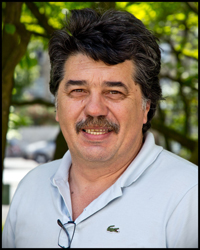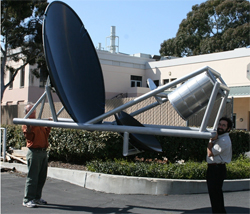Pavel Naselsky receives 6 million kroner for research into the creation of the universe
Pavel Naselsky, professor in the research group Theoretical Particle Physics and Cosmology at the Niels Bohr Institute, has received a grant of 6 million kroner from the Villum Foundation for the construction of a brand new telescope on the Greenland ice sheet. The telescope, called DeepSpace, will look deep into space to observe radiation from the early universe.

Pavel Naselsky has received a grant of 6 million kroner from the Villum Foundation for the construction of a telescope on the Greenland ice sheet. The telescope, called DeepSpace, will look deep into space to observe radiation from the early universe.
The telescope will be placed on Summit in Greenland within the next three years. Summit is located in the middle of Greenland on the ridge of the more than three-kilometer thick ice sheet.
“The atmosphere over Greenland is very clear and transparent, as there is very low humidity due to the cold. There are therefore optimal conditions for seeing far into space in order to observe light from the very early universe,” explains Pavel Naselsky, who with a wry smile adds, that what are bad conditions for people are good conditions for science.
From Summit to Big Bang
But Summit is not entirely desolate and inaccessible. The Americans already have a base there, primarily for climate research. The new project is also a collaboration with Professor Philip Lubin from the University of California, Santa Barbara in the United States, which will be responsible for the basic construction of the telescope, while Denmark will contribute by adapting the telescope so that it can function the Arctic environment.

The DeepSpace project is a collaboration with the University of California, Santa Barbara in the United States, who will be responsible for the basic construction of the telescope, led by Professor Philip Lubin, who is seen on the right in the picture. The telescope is very light with a mirror of 2.2 meters. Denmark will contribute by adapting the telescope so that it can function the Arctic environment. The telescope will be installed in an observatory on the Greenland ice sheet.
Pavel Naselsky will be the scientific head of the project. He also participates in the experiment with the Planck satellite, which in 2013 showed the best images ever taken of cosmic background radiation in 2013. This radiation is the afterglow of the Big Bang and can provide unique information about the creation and evolution of the universe.
“The DeepSpace project on Greenland will contribute observations to characterise the cosmic microwave background radiation. If we observe the specific B-type polarisation, it will be a major breakthrough and will be indirect proof of the existence of gravitational waves, which Einstein’s theory of general relativity predicted,” explains Pavel Naselsky.
The research project is international and in addition to the Niels Bohr Institute and University of California, Santa Barbara, there are also researchers from the Jet Propulsion Laboratory (Caltech, USA), the University of Oslo, Nordita in Sweden and many of the researchers from the Planck experiment will participate in the DeepSpace experiment. With the grant from the Villum Foundation, Pavel Naselsky’s research group will be expanded to four PhDs and postdocs.

Pavel Naselsky, Professor, Theoretical Particle Physics and Cosmology, Niels Bohr Institute, University of Copenhagen. +45 2494-2599, naselsky@nbi.ku.dk
